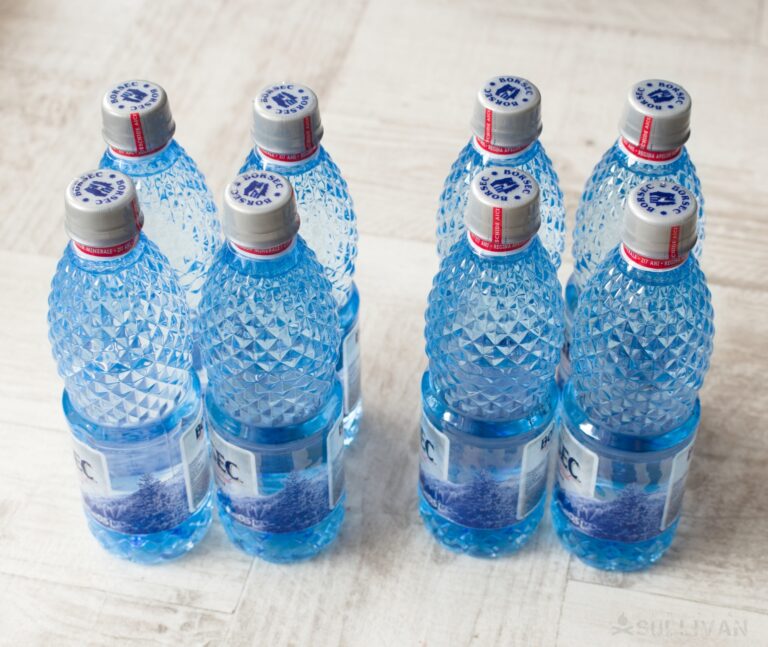Water on the go is important to everyone consequently water bottles are on sale everywhere, in local stores, supermarkets and vending machines. Most of us understand the importance of keeping hydrated.
To stay fit and healthy it is essential to drink half of a gallon of water every day. We need to ask ourselves; how many bottles are there in a gallon?

There are eight 16.9 oz water bottles in a gallon. Here’s why…
In the U.S. a gallon of water has 128 fluid ounces. So, if the water bottle contains 16 fluid ounces, 8 of these bottles will contain a gallon
Another popular size is 12 fluid ounces; there would be 12.6 bottles of this size in a gallon. The most popular size in the U.S. is 16.9 fluid ounces. A total of 7.57 of these bottles would fit into a gallon bottle.
Understanding these units of measurement is a good idea if you’re trying to figure out how much water to keep in your stockpile – as well as how to store that water long term.
It can also help you determine how much water you should be drinking to meet your daily recommended fluid intake.
Figuring out these factors can be a bit challenging, especially if you’re not working with a customary size bottle of water.
Let’s take a closer look to demystify things for you!
What if the Bottle Does Not Contain 16 Fluid Ounces?
There are several different sized bottles available to buy.
The amount of water in each bottle will be different, consequently the number of bottles in a gallon will be different for each one. What do we understand by a gallon? The answer is not straightforward…
We are able to quantify the amount of water that is in a gallon, as 128 fluid ounces. We are able to quantify the amount of water in the bottle by reading the label. To find the number of bottles we employ a simple formula.
Fluid ounces in a gallon ÷ fluid ounces in bottle = bottles in a gallon.
Using the above formula, we have:
- 16 × 8 oz bottles equate to 1 gallon
- 8 × 16 oz bottles equate to 1 gallon
- 4.9 × 26 oz bottles equate to 1 gallon
- 4 × 32 oz bottles equate to 1 gallon
Calculating the different sizes to find the result it can be seen that it does not always work out to an exact number. This is a little surprising, as it would be reasonable to expect that bottle size would be a portion of a gallon.
This is possibly due to the liter system of measurement being widely accepted by many countries affecting the size of water bottles due to standardization.
So, to answer the question of how many water bottles are in a gallon, we have to establish two factors:
- How much water is in a gallon
- How much water is in the bottle
Measurements of liquids can be seen in several formats. They may be expressed in milliliters, fluid ounces, and liters.
To ensure that the question can be answered easily, we should choose one standard measurement. I’ve used fluid ounces, but the result would be the same whichever measure we adopted.
With the measure established a simple formula can be used to find the answer.
Fluid ounces in a gallon ÷ by fluid ounces in bottle = bottles in a gallon
With this formula it is possible to calculate the quantity of any sized bottles of water in a gallon.
What is the Definition of a Gallon?
We need to be sure what definition of a gallon we are using to be able to answer the question accurately. There are actually three measures that are called gallons, but are they all the same?
Imperial Gallon
The imperial gallon is a measurement of volume that is used in certain countries of the world.
The imperial system is sometimes referred to as the British Imperial Systems of Measurement or the UK gallon.
The imperial gallon equates to 154 fluid ounces. To avoid confusion this gallon is generally referred to as the Imperial Gallon.
Of course, within the imperial measurement system, you’ll find other measurements like imperial quarts as well.
Liquid Gallon
The US Liquid Gallon is the predominant gallon measure used in the United States and is simply called a gallon.
If you’re buying water in the US, these will be the most common units of measurement here. The US gallon contains 128 fluid ounces.
Dry Gallon
The Dry Gallon in the US equates to 149 fluid ounces, however.
This measure dating back to the colonial days is rarely used for anything and historically was used to measure a volume of grain certainly not water.
What gallon measure are we using?
The answer to the question would be different for each gallon measure. It is important to decide which measurement we are intending to employ.
We are discussing the United States. It would, therefore, be best to use the predominant standard measurement that is used here.
If we buy gas at a gas station, we need not ask what gallon? We can assume that it is the U S Liquid Gallon.
If you’re curious to know how many gallons are in a 24-pack of water, then read this.
How To Tell if You’re Meeting Your Daily Fluid Intake
Most people know they should be drinking eight 8-ounce glasses of water a day (the recommended daily water intake), but few actually manage to do so. If you’re wondering whether you’re meeting your daily fluid intake, there are a few things you can look for.
First, check the color of your urine. If it’s dark yellow, you’re probably not drinking enough water. Second, pay attention to how often you’re urinating. If you’re going less than four times a day, that’s a sign that you need to drink more fluids. Finally, keep an eye on your energy levels. If you find yourself feeling tired or sluggish, it could be a sign that you need to drink more water.
Other symptoms of dehydration in most people include:
- Thirst
- Vomiting
- Cramps and pain in your joints and muscles
- Fever
On the flip side, there is also something called hyponatremia.
Hyponatremia is a condition that occurs when the sodium levels in your blood become too low. Sodium is an electrolyte that helps maintain the balance of water in your body.
When the level of sodium in your blood drops, it causes the tissues and cells in your body to swell with water. This can cause serious health problems, including seizures, coma, and even death.
Hyponatremia is most commonly caused by medications, such as diuretics, that increase the amount of water in your body and throw off your electrolytes. It can also be caused by excessive sweating, vomiting, or diarrhea.
Hyponatremia usually involves replenishing the fluids in your body with intravenous fluids or saline solution. You can also help prevent it by drinking plenty of fluids and avoiding medications that can cause it.
Is 4 Bottles of Water a Day a Gallon?
A gallon of water is equal to 128 fluid ounces. One bottle of water is typically 16.9 fluid ounces, which means that 4 bottles of water is approximately 68.6 fluid ounces. This means that 4 bottles of water is less than a gallon, by about 59 fluid ounces.
Tips for Storing a Large Number of Water Bottles
If you have recently purchased a large number of water bottles or have been given a large amount of water bottles, you may be wondering how to best store them. Water bottles can be stored in many different ways, but some methods are better than others.
The best way to store water bottles is in a cool, dark place. This can be a closet, pantry, or even the basement.
If you do not have any extra space in your home, you can also store water bottles in boxes in the garage. Just make sure that the boxes are not exposed to direct sunlight or extreme temperatures.
Another tip for storing water bottles is to make sure that they are not close to any chemicals or cleanup supplies. These can include bleach, detergents, and cleaners. The chemicals can leach into the water and make it unsafe to drink.
So there you have it! Everything you need to know about how many ounces of water are in a bottle of water and how many bottles of water are in gallon jugs.
While the amount of water does vary slightly depending on the units of measurement you’re using and the size of the water bottle, these tips should help you figure out the total number of bottles you need (as well as some advice on how to store them long term and make sure you’re drinking enough of them).
Stay hydrated, friends!

Three years ago, I bought an off-grid Cortijo in a small valley in the Andalucian mountains. Although, perhaps the lifestyle is in my genes as my grandfather and his four brothers were Homesteaders in Alberta Canada in the 1900s.
The mountains of Spain are a difficult place to grow many of the flowers that I was used to in the UK. However, veggies grow well year-round. Peppers, tomatoes, potatoes, lettuce, cucumber, melons, and chard all fare well in the Mediterranean climate. Almond trees provide me with a cash crop of around 1 ton while still retaining some to make almond milk and flour.
Meet the rest of the Homesteading Hippy team here.
